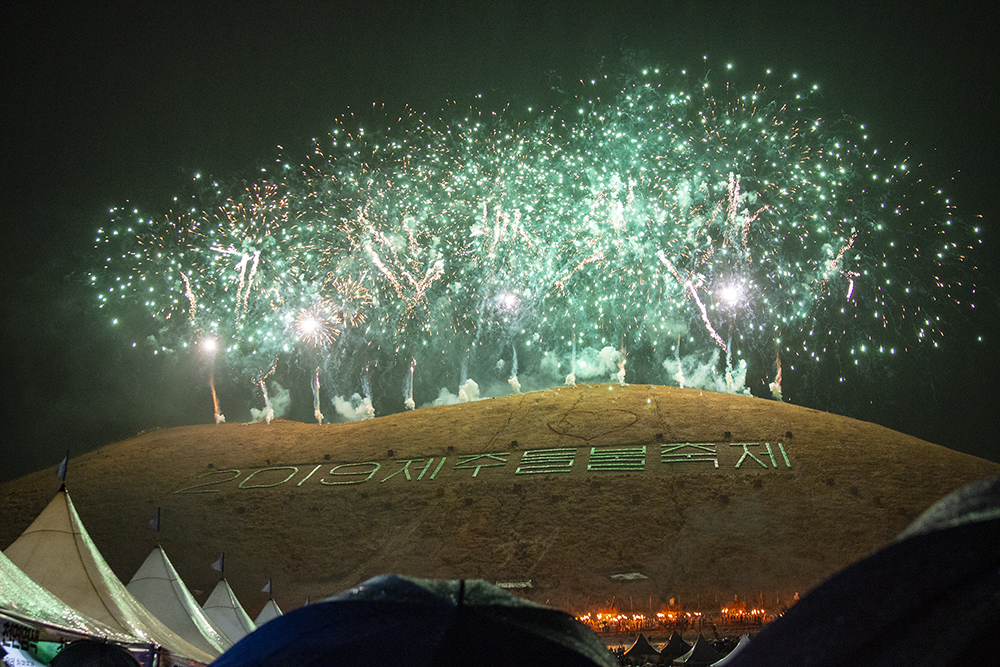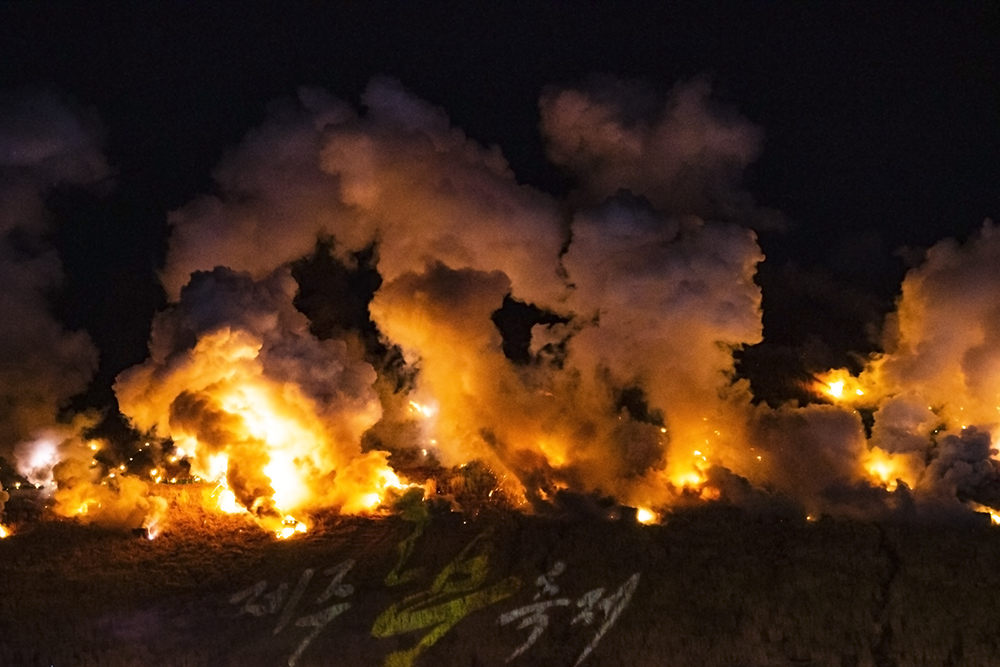Playing with Fire

We live on top of a volcano. Actually, it’s 368 volcanos, all crammed together. I think about this every now and then when I want to feel particularly badass.
Of course, this was unintentional on our part. We came here on the understanding that there was only one potential source of lava-related death on the island: Hallasan, the highest mountain in South Korea. But instead of sweeping smoothly from peak to sea, the landscape around it is bubbled with hundreds of parasitic cones called oreum (오름)—small cratered mountains where eruptions burst through weak points in the crust. There’s roughly one volcanic cone for every two square miles of island. These aren’t the odds we signed up for.
Fortunately 367 of them haven’t been up to much the last 5,000 years.* But every spring, regular as clockwork, one still explodes in flames. There’s a celebration and everything.
“Will you go to the Fire Festival?” a Korean friend asked.
There are two possible reactions to the news that your local community is holding a festival beneath the mouth of an angry volcano. Mine was the less mature.
“Ohmygod we are 100% going!!!”
‘Really?” he sounded mildly surprised.
“Are you kidding? A volcano erupts and you guys throw a party? What a great island!” I pictured the Old Faithful of volcanoes, erupting gloriously into the night while we oohed and aahed from a safe distance… probably behind some kind of rope line.
“Erin…”
“Ooh, can we roast marshmallows?”
My friend did his best to let me down gently, “Erin, there is no lava. They will just light the mountain on fire.”
I stopped hopping up and down. “Sorry?”
“It’s symbolic,” he hesitated, but felt compelled to tell the whole truth no matter how disappointing, “for good agriculture.”
“Ah.”
I hate to sound critical, but if you’re going to hold a festival around the manual ignition of a volcanic mountain, then I think it’s reasonable to expect a chest-thumping, virgin-sacrificing, dramatic appeal to the magma gods. But no, it turns out the Fire Festival is a tribute to agricultural spring cleaning—burning out the old growth to promote the new. Controlled burns called deulbul used to be done all over Jeju. Now it’s just Saebyeol Oreum that gets ritually charred.
“Poor Saebyeol Oreum,” my acquaintance sighed. “Will you still go to the festival?”
“I’m 80% certain we’ll definitely go,” I hedged. “How about you?”
He shook his head. In fact, it turned out that he’d never been to the Fire Festival himself. But he knew enough to impart a warning. “The parking will be terrible.”
My enthusiasm was dwindling, but I tried to reassure him anyway. “It’s ok. I’m 70% sure we’ll take a bus.”
***
Our aging Kia slid precariously though the mud. Sam steered with gritted teeth. I held my breath. This was the furthest parking area from the festival entrance, far beyond where yellow-vested police attempted to direct traffic into orderly lines. There was still a rough pretense at aisles—this was South Korea after all—but cars basically stopped wherever the mood or mud held them. The parking was terrible.
There was only one reason a sane person would abandon the bus for a car: it was raining at the Fire Festival.
The Jeju Fire Festival coincides with the first full moon of the new lunar year, putting it flexibly in March—not the most stable time for weather. According to the official website, the fire-lighting ceremony was still on despite the steady downpour. The site also claimed this was the “world’s largest fire festival” with 300,000 attendees each year. I cynically doubted this. After all that’s half the population of Jeju, and I’d yet to meet a single local who’d ever gone.
Looking across the sea of back-to-front, every-which-way cars, I now saw 300,000 was an understatement. At a guess, I’d say there were a million cars trying to find a spot on the soaked, rutted grass around Saebyeol Oreum.
Our windshield wipers flung themselves frantically back and forth, adding to the tension. Sam, who unlike me hadn’t been expecting a user-friendly Krakatoa but simply a really great photo opportunity, was theoretically excited to be here. But we both knew that if the car got stuck there was no way a tow truck would be able to reach us. I was glad I’d stashed a box of marshmallowy chocopies, the Korean equivalent of twinkies, in the glove compartment just in case.
When we hit an inexplicably cobbled section of ground, Sam pulled the parking brake. We had arrived at the Jeju Fire Festival.
Per the schedule, the daytime hours were filled with traditional shows and activities: horseback riding, a rock-lifting competition, and drum performances. But with the rain everything but the fire-lighting ceremony was cancelled. The grounds overflowed with bored, wet festival-goers killing time until sunset. The vendors did their best, trying to lure people with beer, fish-cakes-on-sticks, or strange antiquities.
Like rotary phones, apparently.
But it was desperate going. We tromped around for a bit until the umbrella obstacle course became too much for Sam, whose height meant he kept getting smacked in the face. We spent the rest of the time huddling in disused corners, trying to keep the camera dry.
As the sun finally set, two brave MCs stepped to the mic, a selfless umbrella-holder right behind them. Instead of gathering at the stage, we took a position on a road poised between the mountain and parking lot. We’d be that much closer to the car when it was over. Unfortunately, half the fairground had a similar idea. We were soon crushed together, trying to see over the umbrellas.
The distant speakers came alive with music. Scenes from Jeju folklore were projected enormously against the mountainside: running horses, swirling waves, the kindly form of Grandmother Seoulmundae, who legend says created the island. Fireworks capped the show, exploding into the night sky.
It was impressive, epic even, but everyone was shifting from foot to foot, glancing back at the wall of people behind them.
C’mon, was the collective attitude as the torch procession slowly assembled and waited for the cue to ignite the mountain. C’mon, get on with it. We had stood in the rain for hours to see a mountain lit on fire and we sure as heck weren’t gonna leave until we’d seen a mountain lit on fire.
Ignition was marked with a sluggish churning of smoke.
Gradually the well-prepped mountain began to catch, until the scraps of fire finally joined in a legible message: 2019 Jeju Fire Festival.
The crowd exhaled relief, snapped the requisite pictures, and turned for the parking lot.
We piled into our car and decided to wait out the worst of the crush. The mountain smoldered in the background, smoke and cinder curling into the sky. The field was a solid mass of automobiles pointed every direction, jammed solid in a honking wall of irritation. The only movement was the spinning wheels of those who’d gotten stuck. We waited. An hour passed. An hour and a half. I broke out the chocopies.
At the two hour mark, the inching began, an agonizing, slow-motion free-for-all that took much of the night to get clear of. I stared idly out the rainspattered window, and thought if Saebyeol Oreum did erupt right now this would be one heck of a Pompeii. I wondered what excavators would make of it – a solid wall of cars parked around an erupting volcano. Probably they’d think we were the kind of idiots who’d show up to an eruption just to watch or something.
I pulled out another chocopie. If marshmallow roasting became a possibility, I figured I might as well be prepared.
-Erin
*Technically, any volcano that’s erupted within the last 10,000 years is considered “active.” So yeah, I just did the laundry on top of 368 live volcanoes. What did you do today?
We'd love to hear from you. If you'd like to leave a comment, head over to our Facebook Page!




